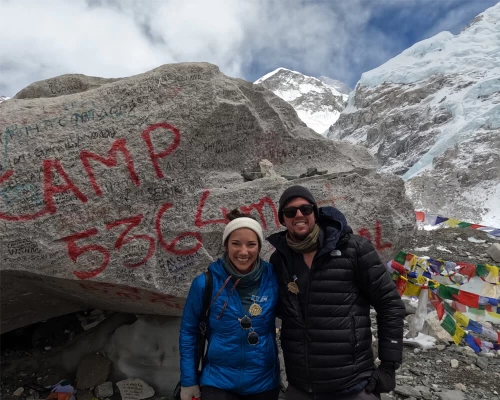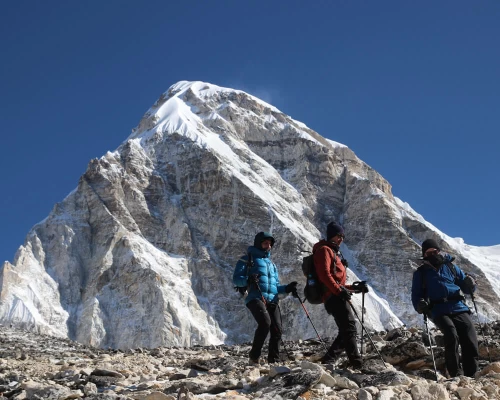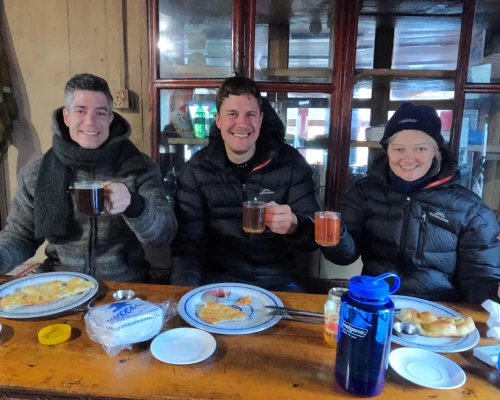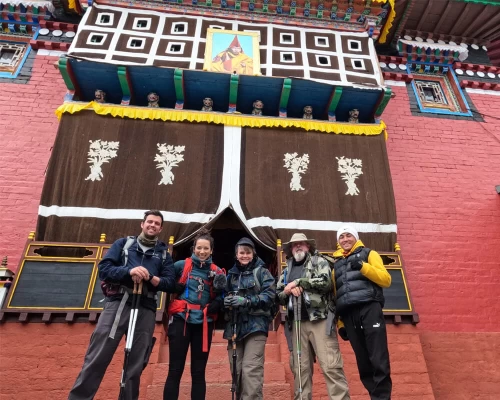A Brief Introduction to the Short Everest Base Camp Trek
Trekking to the base camp of Mount Everest is a legendary and iconic trekking destination in the world. It lies in the southern part of Nepal at an altitude of 5,364 m (17,5989 ft). Every year, thousands of backpackers travel here and return with immense memories and satisfaction. Hiking to the place is a once-in-a-lifetime achievement for every hiking individual.
As you are trekking, the journey leads you through rhododendron forest and vibrant hills, passing through several waterfalls and suspension bridges, and to the moraine in the Alps. This journey is made more serene and appealing by the abundance of prayer wheels, prayer flags, memorials, and historic monasteries that can be found along the route. Additionally, the kindness and hospitality of the people make the hike to the base camp even more breathtaking.
The 8-day Short Everest Base Camp excursion is the perfect home for those who love mountains. In this adventure, you get to witness the three mountains above eight thousand meters and the immense other peak below eight thousand meters. Some of the names of mountains that you will encounter during the venture are Mount Everest (8,848.86 m/29,031.69 ft), Mt. Lhotse (8,516 m/27,940 ft), Makalu (8,485 m/27,838 ft), Ama Dablam (6,812 m/22,349 ft), Pumari (7,161 m/23,494 ft), Thamserku (6,608 m/21,680 ft), Nuptse (7,861 m/25,791 ft), Lobuche Peak (6,119 m/20,075 ft), Tabuche (6,495 m/21,309 ft), and many more.
The Short Everest Base Camp passes through many settlements like Lukla, Phakding, Namche, Tengboche, Pangboche, Dingboche, Lobuche, and Gorakshep. In the meantime, you will see the mixed castes of people in Phakding and Jorsala. Once you cross Jorsala, you will see only sherpas until the Gorakshep. Here, you will get to know the authentic culture and traditions of the Sherpas.
More interestingly, the journey to the 8-day Short Everest Base Camp offers a wide range of magical Himalayas, lovely landscapes, and walking experiences at the glacier. In fact, as you cross Namche Bazaar, in every single step you will enjoy the beautiful vista of the Himalayas and unique meadows, which will make your hike more special and memorable.
The short 8-day Everest Base Camp Trek demands that you push your limits during the venture. There are many health benefits to doing this trek. At the end of this adventure, you are more likely to lose some weight, which will keep you fit and fine. Joining this cruise with the reliable and expert team of Nature Excursion Pvt. Ltd. guarantees to make your dreams come true.
Notably, the short 8-day Everest Base Camp is not only the trekking destination in Nepal; it is just the beginning of the journey. If you are a true nature enthusiast, there are an immense number of nature excursions where you will get to know the wide range of Himalayas, cultures, and landscapes.
Who can join the short 8-day Everest Base Camp trek?
In contrast, the short 8-day Everest Base Camp trek is challenging as well as rewarding. The itinerary has been made in such a way that there is no acclimatization day throughout the journey. To do this trip and to enjoy the excursion, a backpacker needs to have good physical fitness, which assists backpackers in their daily hiking.
What is the age limit for this journey?
To be honest, for the short 8-day Everest Base Camp trek, a backpacker needs to have good physical fitness because there are many ascents and descents on a rough and rocky trail without any acclimatization hike. There is no age limitation for doing this adventure if you are physically fit and ready to dare this hike.
Many travelers over sixty have achieved the short Everest Base Camp trek without any trouble. They are fit and have good physical fitness. We encourage all the backpackers in the world to do regular exercise and keep themselves in good shape if they are planning for such an adventure. It helps a lot.
Is the short Everest Base Camp trek possible for heart patients?
Trekking to the short Everest Base Camp for heart-related patients is not possible. The journey takes you to a high altitude in a cold place, which is bad for them and may lead to serious health conditions. In high altitudes, the density of oxygen is less and the air is cold, which creates problems with breathing. So, it is strongly not advisable for heart patients to do this adventure. If their dream is to see Everest, they can do an Everest Panorama Trek. It is a short and easy itinerary.
How do I prepare for the short 8-day Everest Base Camp trek?
The short 8-day Everest Base Camp route is a moderate-to-challenging itinerary. The trail leads through rough and rocky terrain on an uneven route with several ascents and descents. Rambling at this place in such trail conditions is challenging. As the hike goes higher, hikers may get tired, fatigued, and short of breath. It's common for everyone at high altitude, but if the excursionist comes with a lot of preparation, it will help them in every single step.
In addition, how can a traveler prepare themselves for adventure? Physical fitness is very important when a trekker plans to spend multiple days hiking in nature. For example, everyday regular jogging, weight-lifting, cycling, swimming, yoga, etc. are some of the exercises that you can do at home.
While traveling, physical fitness is very important to make the journey more fun, reliable, and adventurous. We, the team at Nature Excursion Pvt. Ltd., would highly recommend to all nature enthusiasts to follow the above exercise at least one month before the trek starts.
Do I need oxygen gas for the short 8-day Everest Base Camp trek?
Trekking to the base camp of Mount Everest is the activity of rambling at high altitudes. Carrying oxygen is not essential. The lower part has enough oxygen; as the altitude goes higher, the level of oxygen gets thinner. While hiking above four thousand meters, sightseers start to feel shortness of breath. In this situation, a traveler should maintain their speed level, take a small break, and continue with their phase. He or she will feel better.
Notably, while doing activities at high altitudes, a feeling of shortness of breath is common for everyone. Most importantly, how to react to the situation and maintain the phase is more important. Following the guide's instructions and having good physical fitness will be good for the Everest Base Camp trek; if essential, there is oxygen gas at the hotel. Travelers can use it there as well, at an extra cost.
Is it worth it to choose Everest Base Camp with a helicopter return?
The choice of Everest Base Camp trekking with helicopter return is 100 percent worth it if you are a true nature enthusiast. It is one of the most popular trekking destinations due to its sensational beauty and highly prestigious base camp at 5,364 meters.
Also, while heading towards the Everest Base Camp, you will get to witness the authentic culture of the locals, the diversity of flora and fauna, beautiful meadows, and crystal-clear mountains, including three mountains above eight thousand meters.
In addition, the Everest Base Camp Trek with helicopter return gives an experience of mountain flight. The flight will take 12 to 15 minutes back down to Lukla. It will be an extremely outstanding flight with a glorifying glimpse of the mountain ranges. Another thing is that hikers do not need to walk back down the same trail. It will be like a combo experience of both hiking and flying over mountains. The Everest Base Camp with helicopter return is a once-in-a-lifetime experience.
What should I pack for an 8-day Everest Base Camp with a helicopter return?
Trekking to the base camp of Mount Everest is a moderate-to-challenging activity in Nepal. While traveling in the mountains, no one can say the exact weather forecast because of its instability. So, it is very important to pack proper gear and equipment before leaving for an adventure in the mountains.
What should I pack for the 8-day Everest Base Camp trek during the spring?
The weather at Everest Base Camp is relatively mild, neither cold nor hot, and it is considered one of the best times to go trekking here. Spring is one of the big trekking seasons in Nepal, and many people visit from different parts of the world.
In the meantime, a traveler should pack the following: a good sleeping bag, a down jacket, thermals, extra fleece, warm socks, a headlight, a first aid kit, pairs of shocks, sunscreen, hiking boots, poncho-windproof jackets, pants, etc. to make the Everest Base Camp journey more fun and secure.
What should I pack for the autumn?
Autumn is a pleasant time to undertake the Everest Base Camp. The weather gets humid, relatively mild, and gets colder at the end of the season. So, a backpacker should pack the following gear and equipment to make it more reliable and successful. They are sleeping bags, down jackets, headlights, fleece, hiking boots, warm thermals, shocks, warm gloves, beanie hats, windproof jackets, etc.
What to pack for monsoon and winter during the base camp of Mount Everest?
Monsoon and winter are the off-season for trekking in Nepal. In this period, the weather is not favorable because of heavy rainfall in the monsoon and extremely cold temperatures in the winter. But it will be open to those who are ready to face challenges with our expert leaders.
During the monsoon, the surrounding area is wet due to regular heavy rain, and the trail becomes muddy and slippery. In the meantime, trekkers should pack monsoon gear like waterproof jackets and pants, ponchos, bag covers, waterproof boots, warm clothes, down jackets, sleeping bags, etc.
Whereas winter is the time to get snowfall and to get freezing cold, and the temperature drops to -20 degrees or sometimes even more in the upper elevation. When trekking to Everest Base Camp, a backpacker should pack the proper winter gear to stay safe from the cold. Down jacket, sleeping bag, thermals, fleece, thick warm gloves, scarf, warm beanie, water and windproof jackets, warm shocks, headlight, etc.
*Note: Nature Excursion Pvt. Ltd. will provide a down jacket and sleeping bag, both of which are returnable. Go through the equipment list; we have mentioned all the gear required for the trek.
What is the cost of the Everest Base Camp Trek package?
Everest Base Camp is the closest point that one can ever reach without climbing it. Well, the cost of the package is not exactly fixed; it depends on the service that is included and the packages chosen. There are different packages for the Everest Base Camp trek based on the basics of budget and days.
The Everest Base Camp program is categorized into Luxury Everest Base Camp, Standard Everest Base Camp, and the Everest Base Camp Budget Trek. The Everest Base Camp Luxury excursion ranges from $3,000 to $3,500, which includes a helicopter return from Gorak Shep to Lukla. The budget package ranges from $1200 to $1200, and the standard package costs you from $1,500 to $2,400.
Furthermore, when you are planning to do Everest Base Camp, you have the option to choose either a luxury package with extra services and helicopter return from Gorak Shep, a standard package with limited cost, or a budget package with limited services and facilities.
Are there any other options available for the hike to Everest Base Camp?
While Everest Base Camp is no doubt a widely popular trekking destination in the world, there are several other alternative routes. The trekkers' schedules can be accommodated while modifying the itinerary. A typical 12-day route to Everest Base Camp is among the most sought-after packages in the Khumbu Valley. Similar to this, some of the most well-liked packages in the Khumbu region include the Three High Pass trek, the short Everest Base Camp hike, and Gokyo Lake.
Why choose a short Everest Base Camp excursion of 8 days with us?
At Nature Excursion, we understand that when you travel to a new place, you need expert assistance to make your journey more exciting and memorable. That’s why all the leaders working with us have more than a decade of guiding experience in the Himalayas of Nepal.
Aiming for customer satisfaction is our ultimate satisfaction; we never compromise on our services and facilities. Moreover, our expert leaders are more reliable, energetic, well-focused, and friendly in nature to travel with, and they will make your odyssey more beautiful and memorable by singing and dancing to our traditional folk songs.
More importantly, we are transparent in nature, and we do not have any hidden costs. Besides, we offer a very budget-friendly package. By joining us on the short Everest Base Camp voyage, backpackers will return home full of memories and satisfaction.

.webp)
.webp)





-(1).webp)

.webp)
.webp)